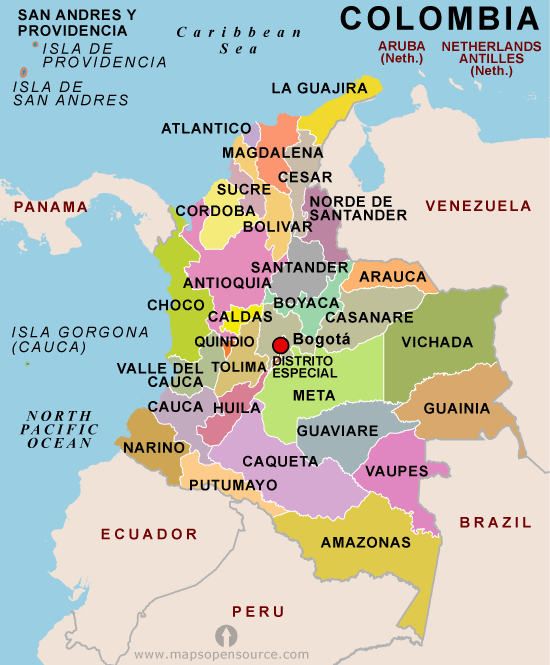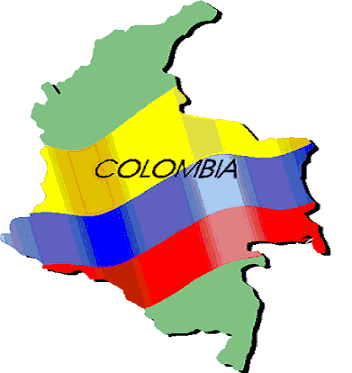
Colombia!
 |  Colombia |  Lost city |
|---|---|---|
 Pink dolphin |  Lost city |  Hotel de Salto ( Haunted House) |
 Fruits |  |  |
 Empanadas |  |  |
 |  |  Tayrona |
 |  Casa Terracota |  Caño Cristales |
 Caño Cristales |  CAÑO Cristales |  Caño Cristales |
 Arepa-Boyaca |  Arepa |  Public clock in Cartagena |
 Cartagena |  valle del cocora |  |
 Catedral las Lajas |  Caño cristales |  |
 Cartagena |  Cartagena |  Senora de Palenque |
 jardin antioquia |
* The name "Colombia" is derived from the last name of the explorer Christopher Columbus.
* Colombia shares a land border with 5 countries including Panama, Venezuela, Brazil, Ecuador and Peru.
* Colombia is the only country in South America that has a coastline on both the Pacific Ocean and the Caribbean Sea.
* Bogotá is the capital of Colombia. It is the second largest capital city in South America and at 2640 m (8661 ft) it is one of the highest capital cities in the world.
* Colombia has a population of over 45 million people (45,745,783) as of July 2013.
* Colombia is classed as a "megadiverse" country, ranking as the 2nd most biodiverse country in the world. It has the highest amount of species by area in the world, including the most endemic species of butterflies, the most orchid species, the most amphibian species and more species of bird than all of Europe and North America combined.
* The currency of Colombia is called the Colombian peso.
* Colombia has a vibrant music scene, two of the most well-known Colombian musicians are Shakira and Juanes.
* The traditional national sport of Colombia is called Tejo. It is a team sport that involves launching projectiles at a target. Check the link
Cuisine:
Colombia's varied cuisine is influenced by its diverse fauna and flora as well as the cultural traditions of the ethnic groups. Colombian dishes and ingredients vary widely by region. Some of the most common ingredients are: cereals such as rice and maize; tubers such as potato and cassava; assorted legumes; meats, including beef, chicken, pork and goat; fish; and seafood. Colombia cuisine also features a variety of tropical fruits such as cape gooseberry, feijoa, arazá, dragon fruit, mangostino, granadilla, papaya, guava, mora (blackberry), lulo, soursop and passionfruit.
Among the most representative appetizers and soups are patacones (fried green plantains), sancocho de gallina (chicken soup with root vegetables) and ajiaco (potato and corn soup). Representative snacks and breads are pandebono, arepas (corn cakes), aborrajados (fried sweet plantains with cheese), torta de choclo, empanadas and almojábanas, Pan de yuca (Therese's favourite :) ) Representative main courses are bandeja paisa, lechona tolimense, mamona, tamales and fish dishes (such as arroz de lisa), especially in coastal regions where suero, costeño cheese and carimañolas are also eaten. Representative side dishes are papas criollas al horno (roasted Andean potatoes), papas chorreadas (potatoes with cheese) and arroz con coco (coconut rice). Organic food is a current trend in big cities, although in general across the country the fruits and veggies are very natural and fresh.
Representative desserts are buñuelos, natillas, torta Maria Luisa, bocadillo made of guayaba (guava jelly), cocadas (coconut balls), casquitos de guayaba (candied guava peels), torta de natas, obleas, flan de arequipe, roscón, milhoja, and the tres leches cake (a sponge cake soaked in milk, covered in whipped cream, then served with condensed milk). Typical sauces (salsas) are hogao (tomato and onion sauce) and Colombian-style ají.
Some representative beverages are coffee (Tinto), champús, cholado, lulada, avena colombiana, sugarcane juice (very good), aguapanela, aguardiente, hot chocolate and fresh fruit juices (often made with sugar and water or milk).
Biodiversity:
Colombia is one of the megadiverse countries in biodiversity, ranking first in bird species. As for plants, the country has between 40,000 and 45,000 plant species, equivalent to 10 or 20% of total global species, this is even more remarkable given that Colombia is considered a country of intermediate size. Colombia is the second most biodiverse country in the world, lagging only after Brazil which is approximately 7 times bigger.
Colombia is the country in the planet more characterized by a high biodiversity, with the highest rate of species by area unit worldwide and it has the largest number of endemisms (species that are not found naturally anywhere else) of any country. About 10% of the species of the Earth live in Colombia, including over 1,900 species of bird, more than in Europe and North America combined, Colombia has 10% of the world’s mammals species, 14% of the amphibian species and 18% of the bird species of the world.
Colombia has about 2,000 species of marine fish and is the second most diverse country in freshwater fish. Colombia is the country with more endemic species of butterflies, number 1 in terms of orchid species and approximately 7,000 species of beetles. Colombia is second in the number of amphibian species and is the third most diverse country in reptiles and palms. There are about 2,900 species of mollusks and according to estimates there are about 300,000 species of invertebrates in the country. In Colombia there are 32 terrestrial biomes and 314 types of ecosystems.